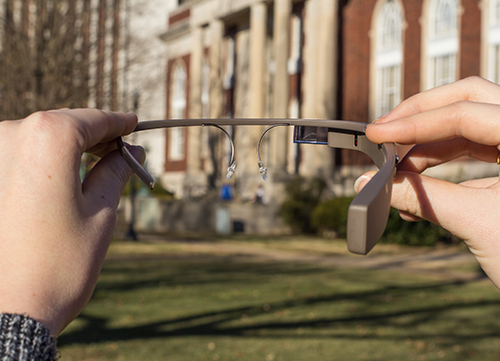
Ben Manhanke, Chief Videographer for The News, uses Waterfield Library’s Google Glass.
Editor’s Note: Chief Videographer Ben Manhanke is one of few Murray State students to use Waterfield Library’s Google Glass. This is his firsthand account to give you, the reader, complete insight on the new technology on our campus.
(WITH VIDEO) – Once you get past looking like an android from a cheesy 1950s science-fiction movie or an extra from Star Trek or Star Wars (take your pick), Google Glass is actually pretty cool.
For the past week I have tried out and experimented with Google’s much-hyped wearable technology, courtesy of the University Libraries, who purchased a pair in May 2014.
This is the first semester the administration is allowing the Google Glass to be checked out.
If you’re wondering why you haven’t heard of the University purchasing Google Glass before, it’s because this is also the first semester libraries are advertising its availability.
After facing several speed bumps, including the first pair needing to be replaced after it unexpectedly stopped working, Waterfield Library is finally ready to check the glasses out to faculty for 72-hour periods.
Part science-fiction and part technology upgrade, Google Glass allows the wearer to surf the web, make phone calls, take pictures and videos and do everything your average smartphone can do.
Using a combination of voice commands and a touchpad located on the frame of the glass, you can manipulate a small heads-up-display projected just in front of your right eye.
Google Glass applications all ran flawlessly, in my opinion. I was able to check my email, get on Facebook and follow Google Maps as it directed me around campus without difficulty.
To manage and operate Google Glass you must download the MyGlass phone app.
This app also allows you to store photos and stream your videos onto your phone so others can see what you’re seeing.
After the initial excitement of the technology wore off – canonized by Time Magazine as the “Best Invention of the Year 2012” – it began to feel like just a computer strapped to my face. It seemed as if the heads-up display and Google Glass in general was more of a novelty gimmick than a useful piece of technology.
Apparently sharing similar misgivings about their product, on Jan. 15, Google announced it would stop manufacturing Google Glass and developing applications for the prototype.
According to the search-engine giant, Google still intends to develop smartglasses for the common man. Further development of this technology will be in the hands of their Google X division, also responsible for designing the self-driving car.
Adam Murray, dean of University Libraries, said he does not consider the $1,500 purchase of Google Glass to be a waste, even now that the product is being discontinued. He said the technology can still serve its intended purpose on campus: educating faculty.

“Delivering courses needs to change as technology changes,” Murray said. “Students have changing expectations for how they’ll interact with their course content. Being able to experiment with technology is pretty important to faculty so they can adapt their teaching styles to the technology that’s available and really try to meet student expectations.”
Google Glass was first introduced to faculty at the 12 Gadgets technology seminar at the request of Elizabeth Price, research and instruction librarian.
12 Gadgets, which is held in December, introduces faculty to 12 new pieces of technology that could be incorporated into the classroom. Hosted by Waterfield Library in partnership with the Center for Teaching, Learning and Technology and the Faculty Development Center, past exhibits have included 3-D printing, Amazon Kindle, Apple iPads and Chromecast.
Price said apart from the 12 Gadgets seminar, faculty has not had the chance to access the Google Glass.
“We had really hoped in the about six months we’ve had them that more people would be able to use them,” Price said. “But the logistics have made it very difficult. In that sense I’m disappointed, but we didn’t know (this problem would arise) going into it.”
The problem is Google Glass’ inability to connect to Murray State’s Wi-Fi.
Most of the glasses’ applications are rendered useless unless professors have phones with a data plan for Google Glass.
Issues with Google Glass included, for me, how long it took to learn to operate certain functions and its lack of functions different from what my phone already has. However, I still think there is a future for this technology.
I can see how professors, as well as other professionals, would utilize this technology. Perhaps faculty might use Google Glass to make a “how-to” video for a course or upload their PowerPoint to the glasses for easy access. I can see surgeons using them to pull up a patient’s X-rays during a procedure or an engineer on site referencing blueprints they’ve saved.
Google Glass may not be perfect, but it is the beginning of what is sure to be a long line of wearable technology.
Story by Ben Manhanke, Chief Videographer